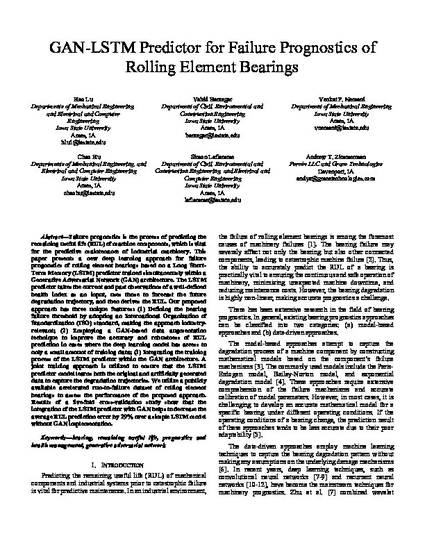
Failure prognostics is the process of predicting the remaining useful life (RUL) of machine components, which is vital for the predictive maintenance of industrial machinery. This paper presents a new deep learning approach for failure prognostics of rolling element bearings based on a Long Short-Term Memory (LSTM) predictor trained simultaneously within a Generative Adversarial Network (GAN) architecture. The LSTM predictor takes the current and past observations of a well-defined health index as an input, uses those to forecast the future degradation trajectory, and then derives the RUL. Our proposed approach has three unique features: (1) Defining the bearing failure threshold by adopting an International Organization of Standardization (ISO) standard, making the approach industry-relevant; (2) Employing a GAN-based data augmentation technique to improve the accuracy and robustness of RUL prediction in cases where the deep learning model has access to only a small amount of training data; (3) Integrating the training process of the LSTM predictor within the GAN architecture. A joint training approach is utilized to ensure that the LSTM predictor model learns both the original and artificially generated data to capture the degradation trajectories. We utilize a publicly available accelerated run-to-failure dataset of rolling element bearings to assess the performance of the proposed approach. Results of a five-fold cross-validation study show that the integration of the LSTM predictor with GAN helps to decrease the average RUL prediction error by 29% over a simple LSTM model without GAN implementation.
Available at: http://works.bepress.com/simon_laflamme/142/

This is a manuscript of a proceeding published as Lu, Hao, Vahid Barzegar, Venkat P. Nemani, Chao Hu, Simon Laflamme, and Andrew T. Zimmerman. "GAN-LSTM Predictor for Failure Prognostics of Rolling Element Bearings." In 2021 IEEE International Conference on Prognostics and Health Management (ICPHM), IEEE, 2021. DOI: 10.1109/ICPHM51084.2021.9486650. Posted with permission.